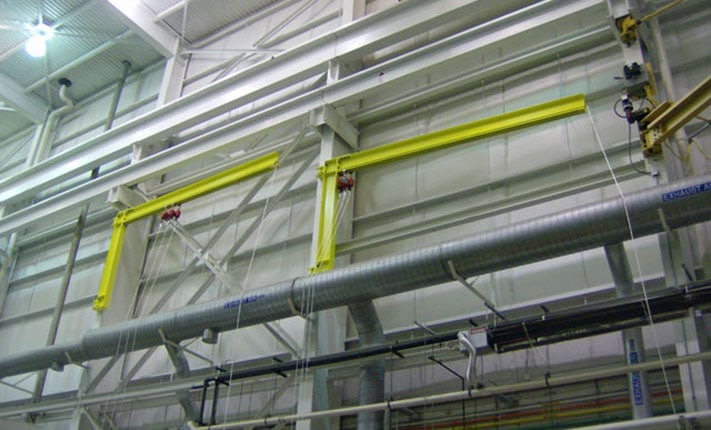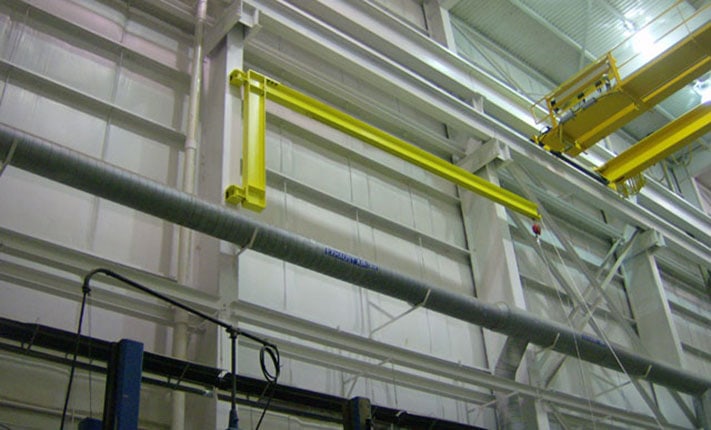Fall Protection & Fall Arrest Systems for the Nuclear Power Industry
OSHA-compliant fall protection for nuclear power plants is an essential component required to keep your maintenance personnel safe and your reactor online. Providing safe access to all of the maintenance areas in your nuclear power plant requires a comprehensive fall prevention strategy, which includes the proper mix of fall protection equipment, a descent and rescue plan, personnel training, and partnering with a fall protection company that appreciates the unique nature of the potential fall hazards associated with your industry.


We are a complete turnkey provider of fall protection systems designed for the nuclear energy industry and have the years of design and installation experience in this market sector. Contact us for expert assistance with your fall arrest, fall restraint and fall protection requirements.
Fall Protection Systems
-
Guardrail
View Guardrail -
Horizontal Lifelines
View Horizontal Lifelines -
Pipe Rack Horizontal Lifelines
View Pipe Rack Horizontal Lifelines -
Loading Platforms, Stairs & Gangways
View Loading Platforms, Stairs & Gangways -
Rescue and Descent Systems
View Rescue and Descent Systems -
Fall Protection Anchors
View Fall Protection Anchors -
Vertical Lifelines and Ladder Systems
Vertical Lifelines and Ladder Systems
Design Considerations
Nuclear Energy Fall Protection Design Considerations
Many of the fall protection design considerations for the nuclear energy industry relate to radiation and minimizing the amount of time maintenance personnel are working in areas that contain high radiation levels. Fall protection systems must allow for quick and easy access to the various monitoring stations located throughout the reactor site, and due to potential radiation contamination concerns, special care must be taken to construct fall protection systems using materials (such as?) that are appropriate for nuclear applications. Nuclear power plants also utilize large pipe rack systems that need to be spanned on foot during inspection and maintenance. Pipe rack systems tend to present elevated, uneven, asymmetrical walking surfaces and typically lack adequate supporting structure to attach a fall protection system. The top level of any pipe rack system also lacks overhead structure to anchor a fall protection system.
OSHA Regulations
- HLL/VLL
- 1926.502(d)
'Personal fall arrest systems.' Personal fall arrest systems and their use shall comply with the provisions set forth below. Effective January 1, 1998, body belts are not acceptable as part of a personal fall arrest system. Note: The use of a body belt in a positioning device system is acceptable and is regulated under paragraph (e) of this section. - 1926.502(d)(8)
Horizontal lifelines shall be designed, installed, and used, under the supervision of a qualified person, as part of a complete personal fall arrest system, which maintains a safety factor of at least two. - 1926.502(d)(9)
Lanyards and vertical lifelines shall have a minimum breaking strength of 5,000 pounds (22.2 kN). - 1926.502(d)(10) 1926.502(d)(10)(i)
Except as provided in paragraph (d)(10)(ii) of this section, when vertical lifelines are used, each employee shall be attached to a separate lifeline. - 1926.502(d)(11)
Lifelines shall be protected against being cut or abraded. - 1926.502(d)(12)
Self-retracting lifelines and lanyards which automatically limit free fall distance to 2 feet (0.61 m) or less shall be capable of sustaining a minimum tensile load of 3,000 pounds (13.3 kN) applied to the device with the lifeline or lanyard in the fully extended position. - 1926.502(d)(13)
Self-retracting lifelines and lanyards which do not limit free fall distance to 2 feet (0.61 m) or less, ripstitch lanyards, and tearing and deforming lanyards shall be capable of sustaining a minimum tensile load of 5,000 pounds (22.2 kN) applied to the device with the lifeline or lanyard in the fully extended position.
- 1926.502(d)
- Personal Fall Arrest Systems
- 1926.502(d)
'Personal fall arrest systems.' Personal fall arrest systems and their use shall comply with the provisions set forth below. Effective January 1, 1998, body belts are not acceptable as part of a personal fall arrest system. Note: The use of a body belt in a positioning device system is acceptable and is regulated under paragraph (e) of this section. - 1926.502(d)(16)
Personal fall arrest systems, when stopping a fall, shall: - 1926.502(d)(16)(i)
limit maximum arresting force on an employee to 900 pounds (4 kN) when used with a body belt; - 1926.502(d)(16)(ii)
limit maximum arresting force on an employee to 1,800 pounds (8 kN) when used with a body harness; - 1926.502(d)(16)(iii)
be rigged such that an employee can neither free fall more than 6 feet (1.8 m), nor contact any lower level; - 1926.502(d)(16)(iv)
bring an employee to a complete stop and limit maximum deceleration distance an employee travels to 3.5 feet (1.07 m); and, - 1926.502(d)(16)(v)
have sufficient strength to withstand twice the potential impact energy of an employee free falling a distance of 6 feet (1.8 m), or the free fall distance permitted by the system, whichever is less.
- 1926.502(d)
- Ladders
- 1926.1053(a)(18)
Fixed ladders shall be provided with cages, wells, ladder safety devices, or self-retracting lifelines where the length of climb is less than 24 feet (7.3 m) but the top of the ladder is at a distance greater than 24 feet (7.3 m) above lower levels. - 1926.1053(a)(19)
Where the total length of a climb equals or exceeds 24 feet (7.3 m), fixed ladders shall be equipped with one of the following: - 1926.1053(a)(19)(i)
Ladder safety devices; or - 1926.1053(a)(19)(ii)
Self-retracting lifelines, and rest platforms at intervals not to exceed 150 feet (45.7 m); or - 1926.1053(a)(19)(iii)
A cage or well, and multiple ladder sections, each ladder section not to exceed 50 feet (15.2 m) in length. Ladder sections shall be offset from adjacent sections, and landing platforms shall be provided at maximum intervals of 50 feet (15.2 m).
- 1926.1053(a)(18)
Talk to a fall protection specialist
Tell us about your fall protection needs, and we’ll configure a system that rises to your challenges.

